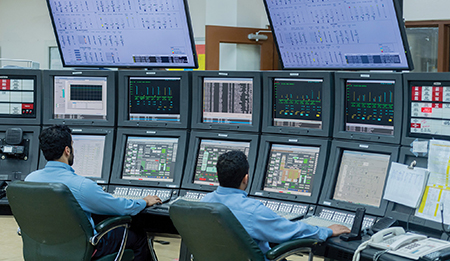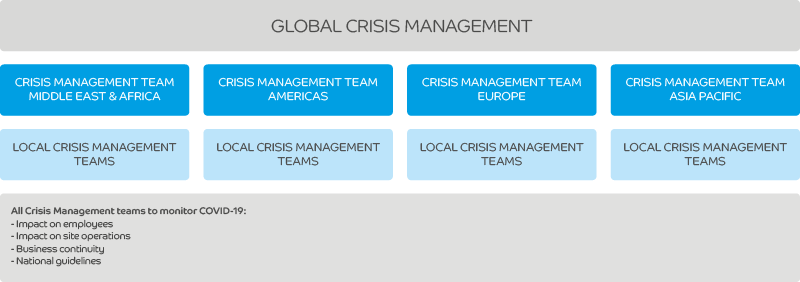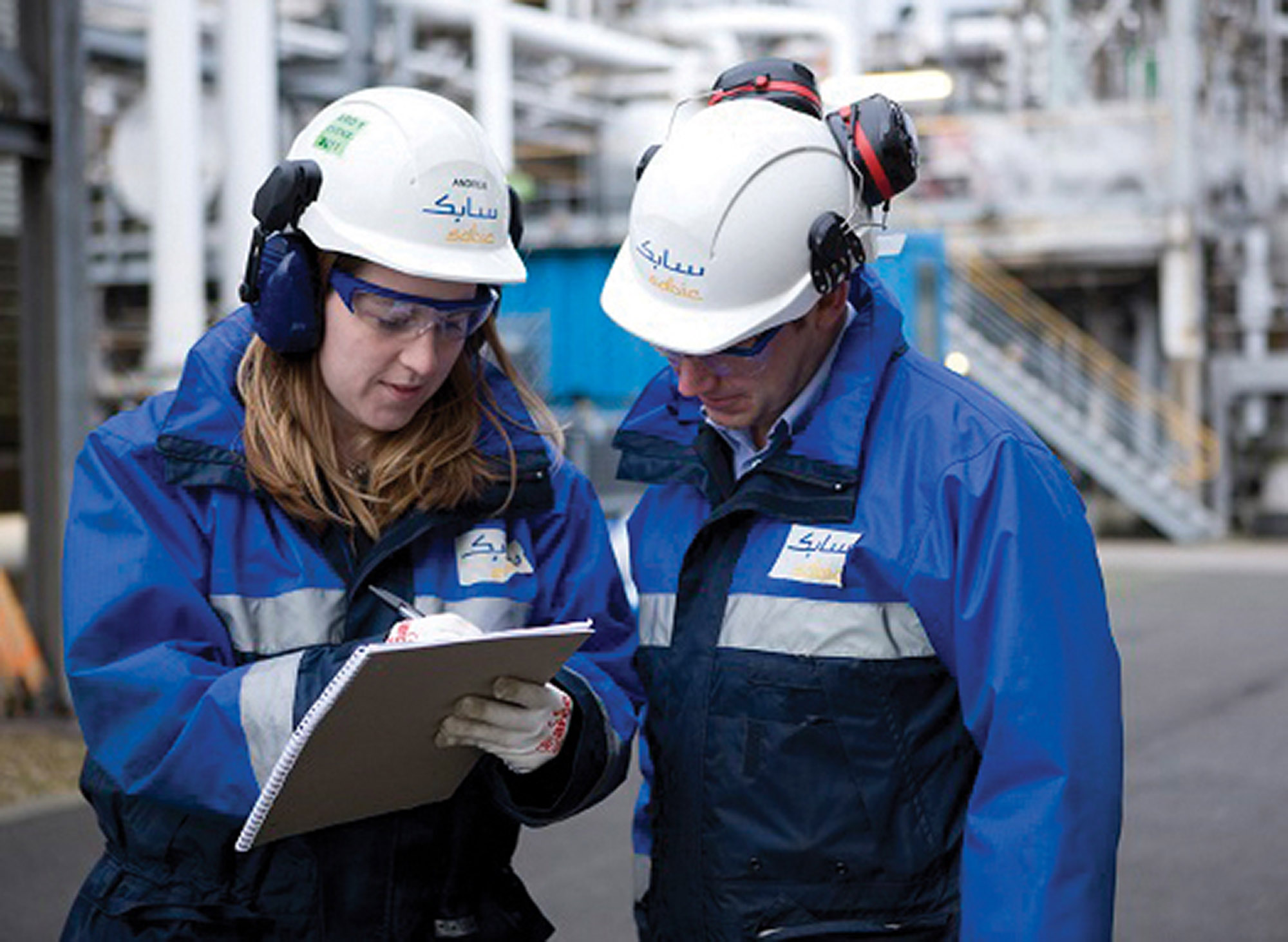RISK AND EMERGENCY RESPONSE MANAGEMENT
PROCESS SAFETY KNOWLEDGE AND COMPETENCY
Risk management is critical to keeping our employees, communities, and business safe and sustainable. We have strategic objectives tied to process safety knowledge and competency development, as well as to risk discovery and management, emergency preparedness and response, and technical network support.
To develop our human capital in 2020, we offered online engagements and virtual programs. Through our continued work with the Mary Kay O-Conner Process Safety Center:
- 27 engineers enrolled in Developing Batch-4 training
- 18 engineers enrolled in Proficient Level Batch 1 training
- 56 professionals attended the Fundamentals of Process Safety training program
- 230 employees participated in Layer of Protection Analysis training online
- 163 SMEs were trained in emergency preparedness, with particular emphasis on pre-incident planning
IMPROVING RISK DISCOVERY AND MANAGEMENT

Hazard identification and risk management are critical to keeping our operations safe
We use the SABIC Assurance for EHSS Risks (SAFER) system for risk identification, assessment, tracking, and mitigation—including during the COVID-19 pandemic. We used eSHEM to perform virtual site assessments in our the Middle East and Africa regions, and we plan to implement this program across our regions. In 2020, we also focused on pre-incident planning, with an emphasis on identifying high-risk scenarios. We developed 140 pre-incident plans for SABIC sites in the Middle East and Africa regions and we trained 121 SABIC employees in the SAFER program.
ENVIRONMENTAL STEWARDSHIP
As part of our Responsible Care® commitment, we monitor regulatory trends and environmental initiatives and engage with the world’s leading chemical associations, including the Gulf Petrochemicals and Chemicals Association (GPCA), the European Chemical Industry Council (Cefic), and the American Chemistry Council (ACC). We address marine litter and microplastics through initiatives like Operation Clean Sweep. In 2020, SABIC evaluated regulatory changes like the Basel Convention Amendments, which focus on plastic waste. We also engaged with the EU on Waste Gas BREF and with Saudi Arabia’s Royal Commission on environmental regulations.
Total Number of Hazardous Substance Accidental Release Incidents
ENVIRONMENTAL INITIATIVES: VOLUNTARY COMMITMENTS
SABIC is part of the WASH4Work, which works to provide water, sanitation, and hygiene in the workplace, and we are working with the World Business Council for Sustainable Development (WBCSD) on their WASH assessment tool and guidance document. We Operation Clean Sweep® (OCS) at SABIC manufacturing sites, and we engage with customers and service providers to promote zero pellet loss across the value chain. We work toward this goal through programs such as a new solids separation unit at our Gelsenkirchen, Germany, site and a truck-cleaning station at Geleen, in the Netherlands. In 2020, SABIC became a VIP member of OCS Blue.
ENVIRONMENTAL RELEASES AND EMISSIONS MANAGEMENT
SABIC aims to eliminate all accidental releases of hazardous substances into the air, water, and waste stream. We track and categorize all accidental releases based on severity, and we manage and minimize our air emissions, water discharge, and waste generation.
In 2020, the total number of hazardous substance release incidents decreased from 27 to 3. The total volume of hazardous substances released decreased to 14.3 metric tons. In 2020, we retrofitted four plant retrofits in Europe and Asia to reduce nitrous oxide (NOx) emissions. In India, we installed a system to monitor wastewater quality and maximize water recycling. We ran an employee-education campaign to improve the recycling rate at our Benoi, Singapore, site.
ENHANCING ENVIRONMENTAL COMPETENCY
We conduct environmental competency-development programs to give new employees the environmental knowledge necessary for their jobs. We have conducted five sessions of the NEBOSH Certification Program, and more than 50% of our environmental experts have participated.
BEYOND COMPLIANCE
Per our Environmental, Safety, Health, and Security Policy, we go beyond compliance, seeking to mitigate environmental risks throughout the life cycle of our manufacturing sites, from initial planning to final decommissioning. We have nearly completed a four-year demolition project at our Teesside site in the UK. This project includes decontamination, isolation, and managing hazardous materials. We have minimized risks to people, the surrounding environment, and SABIC operations, and we expect to recycle up to 95% (by weight) of materials on the site.
CRISIS MANAGEMENT AND COVID-19

SABIC’s COVID-19 response was led by our global and regional crisis management teams and implemented by our crisis management teams at the local level. Corporate Occupational Medicine and Industrial Hygiene provided technical guidance on sanitation, social distancing, ventilation systems, and ways of minimizing worker footprint. We used our Crisis Management Dashboard to visualize impacts on our employees and sites and to track business continuity and CSR efforts. We also tracked community prevalence, recording workplace cases, and performed contact tracing across SABIC sites. Our Operations, Human Resources, and EHSS teams collaborated to activate these systems, streamline communication, and share best practices.
With these measures in place, nearly half of the SABIC population worked remotely, all of our facilities followed national guidelines on shutdown requirements in the regions where we operate, and our manufacturing facilities ran critical operations with precautions to protect employees health and safety.
SOCIAL RESPONSIBILITY
SABIC’s 2020 corporate social responsibility (CSR) efforts focused on helping people affected by the COVID-19 crisis, including healthcare workers, school children, vulnerable populations, and the hungry. In total, SABIC provided more than $46.6 million in funding and materials.

Our focus on regulatory stewardship helps ensure that our policies and operations are aligned with and exceed - regulatory standards in the short and long terms.
